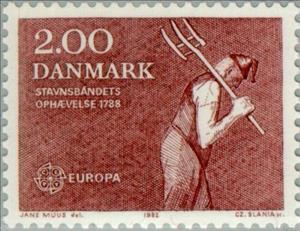Stamp: C.E.P.T.- Historical events (Denmark 1982)
C.E.P.T.- Historical events (Denmark 1982)
03 May (Denmark ) within release C.E.P.T.- Europe goes into circulation Stamp C.E.P.T.- Historical events face value 2 Danish krone
| Stamp C.E.P.T.- Historical events in catalogues | |
|---|---|
| Michel: | Mi:DK 749 |
| Yvert et Tellier: | Yt:DK 752 |
| AFA number: | AFA:DK 747 |
Stamp is horizontal format.
Also in the issue C.E.P.T.- Europe:
- Stamp - C.E.P.T.- Historical events face value 2;
- Stamp - C.E.P.T.- Historical events face value 2.70;
Stamp C.E.P.T.- Historical events it reflects the thematic directions:
A tool is an object that can extend an individual's ability to modify features of the surrounding environment or help them accomplish a particular task. Although many animals use simple tools, only human beings, whose use of stone tools dates back hundreds of millennia, have been observed using tools to make other tools.
The European Conference of Postal and Telecommunications Administrations (CEPT) was established on June 26, 1959, as a coordinating body for European state telecommunications and postal organizations. The acronym comes from the French version of its name Conférence européenne des administrations des postes et des télécommunications.
The Europa postage stamp (also known as Europa - CEPT until 1992) is an annual joint issue of stamps with a common design or theme by postal administrations of member countries of the European Communities (1956-1959), the European Conference of Postal and Telecommunications Administrations (CEPT) from 1960 to 1992, and the PostEurop Association since 1993. Europe is the central theme. EUROPA stamps underlines cooperation in the posts domain, taking into account promotion of philately. They also build awareness of the common roots, culture and history of Europe and its common goals. As such, EUROPA stamp issues are among the most collected and most popular stamps in the world. Since the first issue in 1956, EUROPA stamps have been a tangible symbol of Europe’s desire for closer integration and cooperation.
Agriculture is the cultivation and breeding of animals, plants and fungi for food, fiber, biofuel, medicinal plants and other products used to sustain and enhance human life.[1] Agriculture was the key development in the rise of sedentary human civilization, whereby farming of domesticated species created food surpluses that nurtured the development of civilization. The study of agriculture is known as agricultural science. The history of agriculture dates back thousands of years, and its development has been driven and defined by greatly different climates, cultures, and technologies. Industrial agriculture based on large-scale monoculture farming has become the dominant agricultural methodology.





